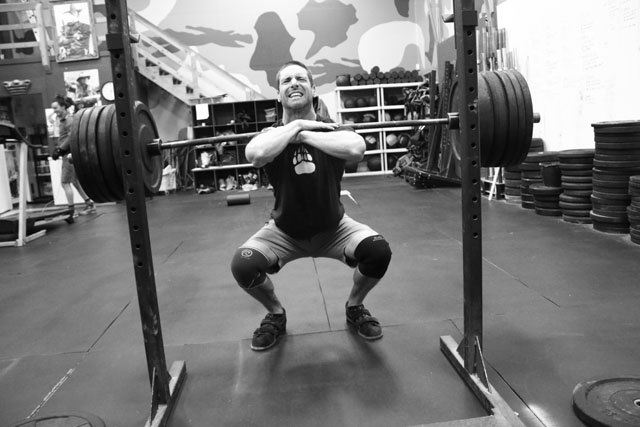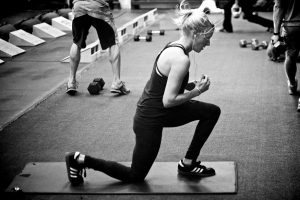By Rob Shaul
First a definition of lower body “push”: we’re talking about training the anterior or front, part of the lower body – the quads.
A lower body “pull” exercise trains the posterior chain of the lower body – butt, and hamstrings.
Below are my current favorite lower body “push” exercises:
1. Front Squat
I came to this exercise late in my own training life. Understand I never received any formal strength coaching in my high school or college years and learned the ropes in the weight room watching other meat heads and reading bodybuilding mags and anything by Arnold. This meant that until my mid-30’s, my go-to lower body strength training exercise was the Back Squat.
Then one day in the tiny weight room I was training in (one rack, one barbell, and a universal machine) a former collegiate athlete was doing sets of Front Squats and I asked to join him. Based on loading alone, I soon discovered Front Squats were a lot harder than Back Squats. I could Back Squat a bunch more than I could Front Squat. Also – Front Squats isolated my quads, unlike any other lift I’d done to that point.
I could lift more with the Back Squat because the barbell placement behind the head places the load over my body’s center of gravity.
The “rack” position of the Front Squat places the barbell forward of my center of gravity and imparts more stress on the midsection as the athlete “drops” into the hole at the bottom of the squat.
For all but a select few athletes with great natural movement, the legs are always stronger than the core for total and lower body strength exercises. Most often, the mid-section fails first on the Front Squat – before the legs – and the athlete collapses forward.
This forward positioning of the barbell also helps explain why the Front Squat does such a better job of isolating the quads over the Back Squat. The behind-the-neck barbell position of the Back Squat allows the hips and butt to do more of the work. The hips and butt also work for the Front Squat, but geometry pushes more work onto the quads.
The Front Squat isn’t perfect. The main issue, especially for men past 30, is wrist flexibility. With ideal positioning, the barbell rests high, right against the athlete’s throat. With the elbows high and parallel to the ground, a “shelf” for the barbell is formed in line with both shoulders and the chest. A perfect “shelf” requires good wrist mobility, however, and poor wrist mobility means the elbows can’t get high enough, the “shelf” isn’t well-formed, and as the athlete drops into the bottom of the squat, the barbell pulls him forward.
Two technique changes can help with this. First is our “two-finger Front Squat technique” seen HERE. Second is holding the barbell “bodybuilder style” with the arms crossed and hands on top, not under the barbell.
I’m 49, and even I now struggle with the “two finger” Front Squat technique because of wrist mobility issues.
While the Front Squat really isolates the quads, another reason I really like this lift is because of the way it works the athlete’s midsection. The Front Squat requires the athlete to isometrically tighten his/her midsection to brace against the barbells attempt to fall forward.
I recently completed the MTI Relative Strength Training Plan which includes Front Squats, and found the Front Squat work left my stomach muscles as sore as my quads!

2. Quadzilla Complex and Leg Blaster
You read right – my second favorite lower body “push” strength exercise(s) are the light dumbbell-only Quadzilla Complex and it’s older brother, the bodyweight-only Leg Blaster.
We’ve actually conducted a Mini-Study comparing the Leg Blaster to the Front Squat for strength increases and found the Leg Blaster to be just as effective as the Front Squat for increasing max effort strength.
How can a light dumbbell or bodyweight-only complex of lower body exercises build absolute strength as well as a classic, heavy, Barbell Front Squat?
Both the Quadzilla Complex and Leg Blaster train eccentric strength – which overall is much more intense and demanding on muscle fibers than concentric strength training.
The difference? Concentric training “shortens” the muscle – think bicep curl or Front Squat on the way up.
Eccentric strength training works while the muscle lengthens – so a “negative” bicep curl in old bodybuilding lingo, or a super slow drop during a back or Front Squat.
The Quadzilla Complex and Leg Blaster both involve a lot of jumping lunges and jump squats. I require athletes to touch their knee down to the floor for each jumping lunge. To avoid smashing their knees into the floor, athletes have to slow their downward drop – which is very intense and trains eccentric strength.
I used Quadzilla Complexes and Front Squats for years as a key part of our Dryland ski pre-season programming. Gravity “bounces” a skier down the slope, and with each bounce, the skier has to slow and stop gravity from forcing him/her into the ground – this requires eccentric leg strength.
But years ago I began deploying Leg Blasters first, and now Quadzilla Complexes (which were developed later) in our limited equipment programming for all athletes as a leg strength training tool.
From a programming perspective, it’s easier to train upper body strength using bodyweight or limited equipment. I can use loading, rings or elevated feet to make push ups harder for upper body pressing, and I can add weight to pull ups and chin ups. But doing this for the lower body is more difficult where many athletes can Front Squat, Back Squat and deadlift much more than their bodyweight. This is where Leg Blasters and Quadzilla Complexes fit in perfectly.
I started programming Leg Blasters into our Afghanistan Pre-Deployment Training Plan. When I first designed this training plan around 2009 I gave it away to military athletes – US and Allies – with deployment orders to Afghanistan – literally thousands of guys. I remember receiving a note back from a Force Recon Marine team leader who received the plan and decided to skip the early weeks and jump right to the final week – and top of the progression for the leg blasters – 5 Fulls. “I had trouble walking for a week” he reported.
These days I will actually deploy Quadzilla Complexes or Leg Blasters in base fitness and other training plans as a primary leg strength exercise where equipment isn’t an issue – simply because they are so effective.

3. Back Squat
I haven’t always favored the Back Squat for leg strength training. I found the Front Squat safer and more focused on the quads. But over the past 2-3 years, I’ve come back to the Back Squat – mainly because of our experience with the exercise as part of our “Super Squat” strength progression.
MTI’s Super Squat strength progression is our interpretation of Dr. Strossel’s famous book and involves completing 20 reps of the Back Squat, with three, deep, slow, breaths between each rep. Athlete’s end up with the barbell on their back for 3-4 minutes and for whatever reason, this progression can result in significantly lower- and total body strength gains.
Safety …. if an athlete fails completing a Front Squat, he/she can easily “dump” the barbell forward, and escape the load.
It’s much more difficult to “escape” the barbell doing a Back Squat. What I’ve seen, and experienced is when the athlete fails, his/her upper body falls forward – and a lot of stress is put on the lower back to try and get the barbell straightened out. I always require a close spot for Back Squats, but even with a spotter, things can get sketchy.
I’ve seen one or two athletes who’ve been able to “dump” the barbell behind them somehow, but this is rare, and I’ve never personally done this.
Regardless – the Back Squat is a classic, proven lower body strength exercise that hammers the quads but also engages the butt, hips, and hamstrings more than the Front Squat.

Questions, Comments, Feedback? Email coach@mtntactical.com
You Might Also Like MTI’s Strength Packet
